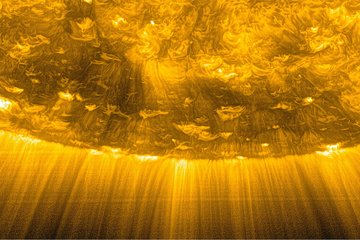All genres
21.
Journal Article
The unusual phase curve of Titan's surface observed by Huygens Descent Imager/Spectral Radiometer. Planetary and Space Science 57, pp. 1963 - 1974 (2009)
22.
Journal Article
Phoenix Soil Physical Properties Investigation. Journal Geophysical Research 114, E00E05 (2009)
23.
Journal Article
Rocks of the Phoenix Landing Site. Journal Geophysical Research 115, E00E09 (2009)
24.
Journal Article
H2O at the Phoenix Landing Site. Science 325 (5936), pp. 58 - 61 (2009)
25.
Journal Article
Microscopy capabilities of the Microscopy, Electrochemistry, and Conductivity Analyzer. Journal Geophysical Research 113, E00A22 (2008)
26.
Journal Article
Dust haze in Valles Marineris observed by HRSC and OMEGA on board Mars Express. Journal Geophysical Research 113, E02004 (2008)
27.
Journal Article
Phoenix Robotic Arm Camera. Journal Geophysical Research 113, E00A17 (2008)
28.
Journal Article
The properties of Titan's surface at the Huygens landing site from DISR observations. Planetary and Space Science 56, pp. 728 - 752 (2008)
29.
Journal Article
Observations of atmospheric water vapor above the Tharsis volcanoes on Mars with the OMEGA/MEx imaging spectrometer. Icarus 194 (1), pp. 53 - 64 (2008)
30.
Journal Article
The reflectance spectrum of Titan's surface at the Huygens landing site determined by the Descent Imager/Spectral Radiometer. Planetary and Space Science 56, pp. 753 - 769 (2008)
31.
Journal Article
Optical properties of aerosols in Titan's atmosphere. Planetary and Space Science 56 (5), pp. 660 - 668 (2008)
32.
Journal Article
Introduction to special section on the Phoenix Mission: Landing Site Characterization Experiments, Mission Overviews, and Expected Science. Journal Geophysical Research 113, E00A18 (2008)
33.
Journal Article
Loss of the surface layers of comet nuclei. Space Science Reviews 138 (1-4), pp. 165 - 177 (2008)
34.
Journal Article
Craters, smooth terrains, flows, and layering on the comet nuclei. Solar System Research 41 (2), pp. 109 - 117 (2007)
35.
Journal Article
Properties of the dust cloud caused by the Deep Impact experiment. Icarus 187, pp. 208 - 219 (2007)
36.
Journal Article
Osiris - The Scientific Camera System onboard Rosetta. Space Science Reviews 128, pp. 433 - 506 (2007)
37.
Journal Article
Observations of Comet 9P/Tempel 1 around the Deep Impact event by the OSIRIS cameras onboard Rosetta. Icarus 187, pp. 87 - 103 (2007)
38.
Journal Article
A comet nucleus sample return (CNSR) mission in ESAs Cosmic Vision program. Geochim. Cosmochim. Acta 71, p. A531 (2007)
39.
Journal Article
Determination of the light curve of the Rosetta target asteroid (2867) Steins by the OSIRIS cameras onboard Rosetta. Astronomy and Astrophysics 462, pp. L13 - L16 (2007)
40.
Journal Article
Venus monitoring camera for Venus express. Planetary and Space Science 55 (12), pp. 1701 - 1711 (2007)










